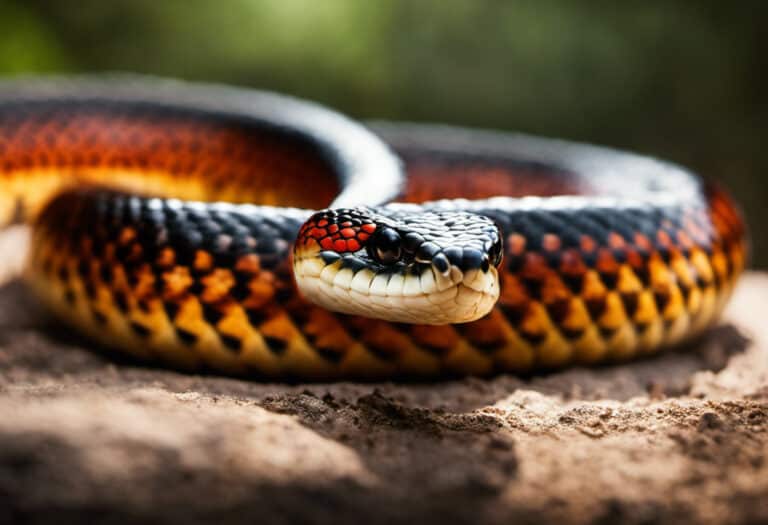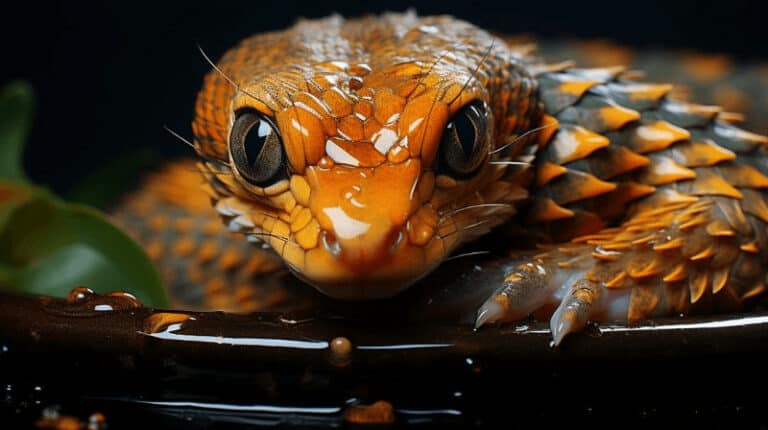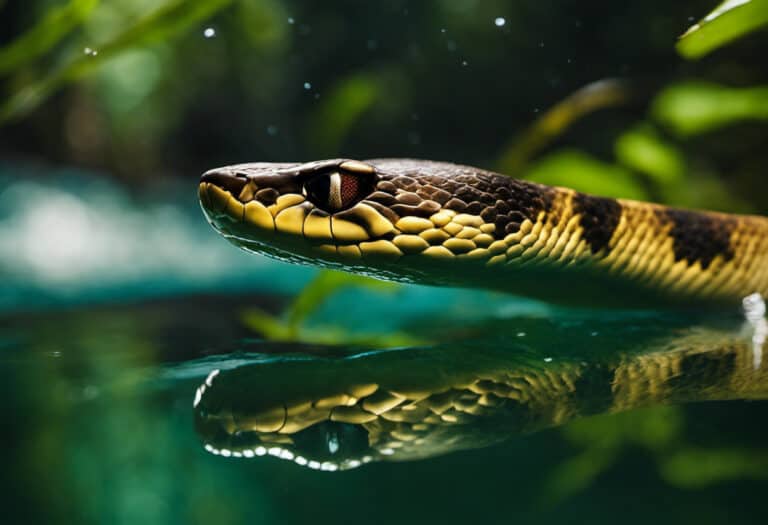Do Garter Snakes Lay Eggs?
Do you ever wonder if garter snakes lay eggs?
Well, prepare to be surprised! Contrary to popular belief, garter snakes do not lay eggs like many other snake species. Instead, these remarkable creatures give birth to live baby snakes.
In this article, we will delve into the fascinating world of garter snake reproduction, debunking the myth surrounding their egg-laying abilities.
So, if you’re ready to uncover the truth behind this commonly misunderstood topic, keep reading!
Key Takeaways
- Garter snakes do not lay eggs; they give birth to live young.
- Some snake species, like corn snakes and king snakes, lay eggs.
- Snake eggs can take up to two months to hatch.
- Removing snakes during winter may result in their death due to cold temperatures.
The Reproduction Process of Garter Snakes
Garter snakes, like other snake species such as anacondas and rattlesnakes, give birth to live babies instead of laying eggs. The reproductive process of garter snakes involves specific mating behaviors and unique reproductive anatomy.
Female garter snakes release pheromones to attract males for mating. Once mating occurs, the female stores sperm until she’s ready to fertilize her eggs. The female then carries the developing babies inside her for approximately 2 to 3 months. During this time, she establishes a nest where she’ll safely give birth to 20 to 40 live baby garter snakes.
It’s fascinating to observe how these independent baby snakes must find food and survive on their own from the moment they’re born. Understanding the intricacies of garter snake reproduction enhances our appreciation for the diversity and adaptability of these remarkable creatures.
Live Birth Vs. Egg Laying: the Truth About Garter Snakes
You may be surprised to learn that not all snakes lay eggs; some, like garter snakes, give birth to live young. Garter snakes have unique mating habits and nesting preferences that contribute to their reproductive success.
- Garter snakes release pheromones to attract male snakes for mating, ensuring successful reproduction.
- After mating, the female stores sperm until she’s ready to fertilize her eggs, allowing for control over the timing of conception.
- The female carries the developing embryos inside her for approximately 2 to 3 months, providing a safe and nourishing environment for their growth.
- When it’s time to give birth, the female garter snake establishes a nest in warm places, such as attics, under houses, or inside sheds, ensuring the survival of her live babies.
Understanding garter snake mating habits and nesting preferences is crucial for appreciating their unique reproductive process and ensuring their freedom to thrive in their preferred environments.
The Surprising Facts About Garter Snake Nesting
If you come across a garter snake nest in your home, it’s important to seek professional help for safe removal and relocation.
Garter snakes exhibit interesting nesting behavior as part of their reproductive strategies. The female garter snake carries her babies inside her for about 2 to 3 months before giving birth to live young.
She establishes a nest in a warm location, such as attics, under houses, or inside sheds. Garter snakes prefer these warm places, especially during the winter months.
Removing garter snakes should be done with the assistance of professionals to ensure humane treatment and to prevent harm to the snakes. It’s crucial to avoid removing snakes during winter, as exposing them to cold temperatures may lead to their death.
Seek expert help for the safe relocation of garter snakes while respecting their nesting behavior and reproductive strategies.
Why Removing Garter Snakes Requires Professional Help
Removing garter snakes requires professional help due to the expertise required to ensure their humane removal. Professionals have the knowledge and experience to handle the snakes safely, minimizing stress and harm to both the snakes and humans.
Additionally, removing garter snakes during cold weather poses risks to their survival, as they rely on warm places for nesting. Professional help can provide appropriate relocation options to ensure the snakes are safely and responsibly removed from the area.
Expertise Ensures Humane Removal
Seeking professional help for the removal of garter snakes ensures humane treatment and proper relocation. The expertise of these professionals guarantees that the removal process is conducted with care and respect for the snakes. Here are four reasons why professional help is essential:
- Expert knowledge: Professionals have the necessary knowledge and experience to handle garter snakes safely and effectively.
- Humane treatment: Professionals understand the importance of treating garter snakes with compassion and minimizing any harm or stress during the removal process.
- Proper relocation: Professionals know the appropriate locations to relocate the snakes, ensuring their survival and minimizing any negative impact on the environment.
- Peace of mind: By hiring professionals, you can have peace of mind knowing that the removal process is being handled by experts, allowing you to focus on other aspects of your life.
Cold Weather Risks Removal
During cold weather, it’s important to consider the risks of removing garter snakes from their nests. Garter snakes seek warm places for nesting, especially during winter. Removing them during this time can result in their death due to the cold temperatures.
To ensure humane treatment and the survival of these beneficial snakes, it’s crucial to seek professional removal services. They’ve the expertise to safely relocate the snakes to a suitable environment. Attempting removal without professional help may lead to harm to both the snakes and the person attempting removal.
Consulting experts in pest or snake removal is the best course of action to coexist with garter snakes while ensuring their well-being. Remember, garter snakes play an important role in the ecosystem, controlling pests, and should be appreciated and respected.
Professional Relocation Options Available
If you want to ensure the safe relocation of garter snakes, it’s important to consult professional removal services. These experts have the knowledge and experience to handle the process effectively.
Here are some reasons why professional relocation services are essential:
- Expertise: Professionals understand the behavior and habits of garter snakes, ensuring a successful relocation without harm to the snakes or the environment.
- Humane treatment: Professional removal methods prioritize the well-being of the snakes, using strategies that minimize stress and ensure their safety during the process.
- Legal compliance: Snake removal experts are familiar with local regulations regarding the relocation of wildlife. They’ll ensure that all necessary permits and guidelines are followed.
- Peace of mind: By hiring professionals, you can have peace of mind knowing that the snakes will be safely and responsibly relocated, allowing you to coexist with nature in a harmonious way.
Common Misconceptions About Garter Snake Reproduction
You may be surprised to learn that not all snakes lay eggs, and this includes garter snakes. Contrary to popular belief, garter snakes give birth to live young instead of laying eggs. This is just one of the many misconceptions surrounding snake reproduction.
Many people mistakenly assume that all snakes lay eggs, but in reality, there are several snake species, including garter snakes, that give birth to live babies. To help you better understand garter snake mating habits and clear up any misconceptions, here is a table outlining some key facts:
| Garter Snake Mating Habits | Misconceptions about Snake Reproduction |
|---|---|
| Female releases pheromones to attract males | All snakes lay eggs |
| Female stores sperm until ready to fertilize eggs | Garter snakes lay eggs |
| Female carries babies for 2-3 months | All snake species give birth to live babies |
| Female establishes nest for birth | Snake eggs take up to two months to hatch |
| Baby garter snakes are independent | Removing snakes during winter may result in their death due to cold temperatures |
Understanding the true nature of garter snake reproduction will help dispel any misconceptions and foster a greater appreciation for these fascinating creatures.
The Importance of Garter Snakes in the Ecosystem
Garter snakes play a vital role in the ecosystem as predators, helping to control pest populations such as rodents and insects. Their presence helps to maintain a balanced food chain and prevent the overpopulation of certain species.
While they may seek warm places to nest, coexisting with garter snakes is possible, and professional help can be sought for their safe removal if necessary.
Ecosystem Role of Garter Snakes
Garter snakes play a crucial role in maintaining the balance of the ecosystem and contribute to the local food chain. They exhibit fascinating behavior and have specific habitat preferences.
- Garter snakes are active during the day and are commonly found near water bodies, such as ponds, streams, and marshes. They’re excellent swimmers and climbers, allowing them to explore various habitats.
- Garter snakes are known for their ability to camouflage, blending in with their surroundings to avoid predators. They primarily feed on small vertebrates, such as frogs, toads, and small mammals.
Understanding garter snake behavior and their habitat requirements is essential for their conservation and the preservation of biodiversity in the ecosystem. Appreciating the freedom they have to thrive in their natural environment is key to maintaining a healthy ecosystem.
Pest Control Benefits
Having garter snakes around can be beneficial for pest control in your area.
Garter snakes are known for their feeding behavior, which primarily consists of small vertebrates such as frogs, toads, and mice. They’re also known to consume insects, slugs, and earthworms.
Garter snakes are active hunters and use their keen sense of smell to locate their prey. They’ve a unique feeding behavior where they swallow their prey whole, aided by their flexible jaws.
Garter snakes have been observed to exhibit opportunistic feeding behavior, meaning they’ll consume whatever prey is available to them. This adaptability allows garter snakes to play a crucial role in controlling pest populations in your environment.
Coexistence and Removal Options?
If you find a garter snake nest in your home, it’s recommended to contact an expert in pest or snake removal for safe relocation options. Removing garter snakes should be done with professional help to ensure humane treatment.
Seek professional help for relocation if needed. Coexisting with garter snakes is possible and they can be removed easily. Appreciate and respect the presence of garter snakes in the environment.
They play an important role in the ecosystem and local food chain, helping control pests. Remember, garter snakes don’t lay eggs; they give birth to live young. Killing garter snakes isn’t recommended; seek professional help for removal.
Coexisting With Garter Snakes: Tips and Considerations
Coexisting with garter snakes in your space is possible and they can be easily removed if needed.
Garter snakes are known for their docile nature and aren’t typically aggressive towards humans. Understanding snake behavior and their preferred habitats can help create a harmonious environment.
Garter snakes are commonly found in grassy areas, wetlands, and gardens, as they prefer moist and cool environments. Providing alternative hiding spots and limiting access to food sources can discourage snakes from entering your space.
If you do encounter a garter snake in your home and wish to remove it, it’s recommended to seek professional help to ensure the snake’s safety and humane treatment. Remember, coexistence is possible, but if removal is necessary, professional assistance is advised.
The Role of Temperature in Garter Snake Survival
To ensure the survival of garter snakes, it’s important to understand the role that temperature plays in their well-being. Temperature affects various aspects of a garter snake’s life, from their metabolism to their ability to reproduce and find food.
Here are four key ways in which temperature impacts the survival of garter snakes:
- Thermoregulation: Garter snakes are ectothermic, meaning they rely on external sources of heat to regulate their body temperature. They bask in the sun to warm up and seek cool shelter to avoid overheating.
- Reproduction: Temperature influences the timing and success of garter snake reproduction. Females require specific temperatures for egg development and incubation, while males need warm temperatures to maintain reproductive activity.
- Hunting and digestion: Garter snakes are more active and efficient hunters in warmer temperatures. They rely on warmth to increase their metabolism and digestion rate, allowing them to capture and process prey effectively.
- Hibernation: Temperature plays a crucial role in garter snakes’ hibernation. They seek out secure hibernation sites with stable temperatures to conserve energy during the winter months.
Understanding the role of temperature in the survival of garter snakes is essential for their conservation and maintaining the delicate balance of ecosystems they inhabit.
Snake Eggs: How Long Does It Take for Garter Snakes
Snake eggs typically take around two months to hatch, so you can expect the baby garter snakes to emerge after that period.
Garter snakes have specific nesting habits, often seeking warm places for nesting, especially during the winter. These can include attics, under houses, and inside sheds.
However, if you discover a garter snake nest in your home, it’s important to seek professional help for removal to ensure the humane treatment of these creatures. Removing garter snakes during the winter months may result in their death due to cold temperatures.
It’s crucial to coexist with garter snakes and appreciate their presence in the ecosystem as they play a significant role in controlling pests and maintaining the local food chain.
If relocation is necessary, it’s recommended to consult experts for safe and proper garter snake removal techniques.
Appreciating and Respecting Garter Snakes in Nature
You can gain a deeper understanding and appreciation for garter snakes by learning about their significant role in controlling pests and maintaining the local food chain. Garter snakes exhibit fascinating behavior and have specific habitat preferences that contribute to their success in the natural world.
Garter Snake Behavior:
- Garter snakes are known for their ability to eat a variety of pests, including insects, slugs, and small rodents.
- They’re non-venomous and use constriction to capture and subdue their prey.
- Garter snakes are also excellent swimmers and climbers, allowing them to navigate different terrains and hunt effectively.
- These snakes have a unique defense mechanism of releasing a foul-smelling musk when threatened, deterring potential predators.
Garter Snake Habitat:
- Garter snakes can be found in a wide range of habitats, including forests, grasslands, wetlands, and even suburban areas.
- They prefer areas with vegetation cover, as it provides shelter and camouflage.
- Garter snakes are ectothermic, relying on external sources of heat to regulate their body temperature, so they often bask in the sun or seek warm spots like rocks or pavement.
Understanding garter snake behavior and their habitat requirements can help us appreciate their importance in maintaining a balanced ecosystem. By respecting their presence and coexisting with them, we can ensure their continued role in pest control and the local food chain.
Frequently Asked Questions
Can Garter Snakes Lay Eggs?
Yes, garter snakes can lay eggs. Their reproduction involves the female storing sperm after mating and then fertilizing her eggs. However, it is important to note that garter snakes primarily give birth to live young.
Is It Safe to Remove Garter Snakes From Your Home Without Professional Help?
It’s not safe to remove garter snakes without professional help. Misconceptions exist, but these snakes play a vital role in the ecosystem. Seek expert assistance to ensure their safety and coexistence.
How Long Does It Take for Garter Snake Eggs to Hatch?
Garter snake egg development refers to the incubation period. The time it takes for garter snake eggs to hatch can vary, but it generally ranges from several weeks to a few months.
What Are Some Common Misconceptions About Garter Snake Reproduction?
One common misconception about garter snake reproduction is that they lay eggs. In reality, garter snakes give birth to live young. Understanding this fact is important for accurate knowledge about these fascinating creatures.
Why Are Garter Snakes Important in the Ecosystem?
Garter snakes are crucial for maintaining ecosystem balance. They play a vital role in controlling pest populations, helping to keep them in check. Appreciate and respect their presence as they contribute to the overall health of the environment.
Conclusion
In conclusion, garter snakes defy the common misconception that all snakes lay eggs. Female garter snakes carry their babies inside them for a few months and give birth to live young. This unique reproductive process sets them apart from other snake species.
Despite some concerns about their presence, it’s important to appreciate and respect garter snakes in nature, as they play a vital role in maintaining the balance of ecosystems. Removing them should only be done by professionals to ensure their safety and the preservation of their habitats.






